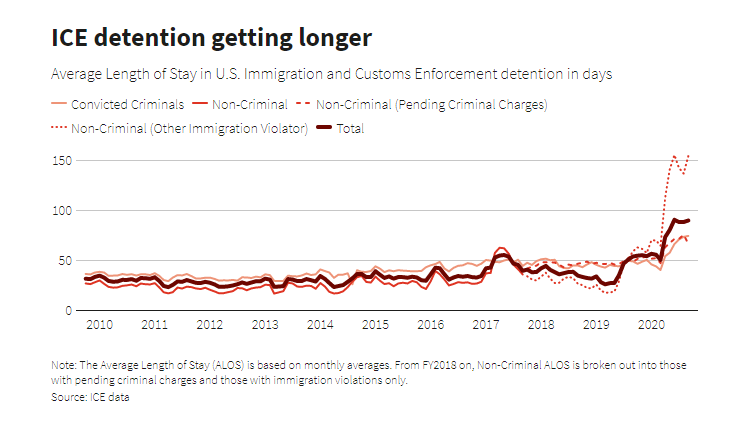By Mica Rosenberg and Kristina Cooke
NEW YORK, NY, Mon. Oct. 12, 2020 (Reuters) – The 31-year-old Cuban rancher arrived at the U.S.-Mexico border after crossing through nearly a dozen countries to seek political asylum in the United States.
More than a year later, Yudanys Perez remains locked up. As he presses his legal case, he’s been shuttled among six immigration detention centers and denied parole seven times.
In May, medical records show, he tested positive for the coronavirus. For more than a month, he suffered fever, shakes and diarrhea in a dormitory with dozens of other sick detainees, he said during a telephone interview from the Winn Correctional Center in rural Louisiana.
“Especially since the coronavirus pandemic began, I worry every day about my survival,” he said in a declaration earlier this year in an ongoing federal lawsuit brought on behalf of hundreds of detained asylum seekers.
Amid a global health emergency, immigrants are being held in U.S. Immigration and Customs Enforcement (ICE) detention for longer than any period in at least a decade, according to ICE data on monthly averages analyzed by Reuters. More than 6,400 detainees have contracted COVID-19 in ICE detention centers around the country, and eight have died.
Reuters spoke to 20 detainees from Africa and Latin America who said they had been held in ICE detention for more than six months. Each described cramped and sometimes unsanitary conditions, which made social distancing virtually impossible and control of COVID-19 infections and other diseases difficult.
The agency has also continued to transfer detainees among centers during the pandemic, seeding or exacerbating outbreaks in some cases.
Detention centers now house fewer than half as many people as before the pandemic – less than 20,000 as of early October – in part because emergency health measures established in March have allowed authorities to expel nearly 150,000 migrants at the border.
At the same time, the ICE data show, the average amount of time immigrants spent in U.S. detention almost tripled to three months this September compared to September 2016, before President Donald Trump took office. Detainees in September 2020 were being held nearly double the amount of time as in September 2019.
ICE officials did not dispute Reuters findings on increased periods of detention. The agency said the pandemic has hindered swift deportation of detainees because some countries have closed their borders or been unwilling to consistently accept returnees. ICE also said the health crisis has delayed U.S. immigration court proceedings and asylum screenings.
ICE spokeswoman Danielle Bennett said the agency is “committed to adhering to U.S. Centers for Disease Control guidance on detention levels and minimizing the spread of the virus.”
Determinations about who is released are made on a case-by-case basis “as a matter of discretion or as a matter of controlling law or court decisions,” Bennett said.
‘VERY SCARY’
The agency could make greater use of its wide discretion by releasing more detainees on parole, bond or their own recognizance, several immigration attorneys, former ICE officials and public health experts familiar with ICE detention practices said.
Some of these sources said migrants may be kept longer because of the way the detention system is funded.
Congress looks at the prior year’s average detention numbers to decide how much to allocate to ICE and its parent agency, the U.S. Department of Homeland Security (DHS), in the future.
“Because of the Trump Administration’s severe practices at the border, the total number of detainees in ICE custody is far below budgeted levels,” said Kevin Landy, a former ICE detention official. “This creates an incentive for DHS to limit discretionary detainee releases and slow down asylum processes, to keep its detained population as high as possible.”
In response, ICE said that 2020 was an exceptional year due to the pandemic and Congress would likely take this into account when setting next year’s funding levels.
Overall, about half the people currently in detention have been convicted of crimes in the United States and often come into custody after they have finished serving U.S. jail or prison sentences, ICE data show.
In 2019, the most common convictions were for drunk driving, followed by drug offenses, criminal immigration violations – such as illegally crossing the border multiple times – and traffic offenses, like driving without a license.
About a third of detainees have committed civil immigration violations, such as overstaying a visa. These people are stuck in detention the longest – more than five months on average in September, according to the ICE data. The rest of those detained have been charged with crimes but not yet convicted.
Reuters spoke to a wide range of detainees – men and women from Burkina Faso, Mali, Sierra Leone, Sudan, Cuba and Venezuela, as well as Mexico and Central America.
Sandra Cervantes, 26, whose parents brought her from Mexico when she was 6 months old, lost her Deferred Action for Childhood Arrivals (DACA) protection after being convicted of drunk driving causing injury. The Los Angeles resident said she was given five years of probation.
In August 2019, she was again before a judge after missing a probation appointment in June, according to court records. Police records show she reported having been raped and falsely imprisoned that month, something she said kept her from attending to her own criminal case.
She was released by the court but was detained by ICE that same day and has been at the Adelanto detention center near Los Angeles ever since, fighting deportation to a country she last lived in as a baby. “I’m so remorseful for what happened,” she said of her drunk driving offense.
ICE said Cervantes was a “convicted criminal alien, who has been ordered removed by an immigration judge.”
More than 100 Adelanto detainees have tested positive for COVID-19 since early September, according to ICE data. At least 16 detainees have been hospitalized for COVID-related symptoms since then but most have since recovered and returned to the center, ICE said. The agency said it provides masks to staff and detainees at Adelanto, regularly disinfects common areas and is staggering meals and recreation times.
But Cervantes worries about contracting the coronavirus in her dorm, where she bunks with nine other women. “It’s kind of dirty in here, and we’re close to each other,” she said.
A former dorm mate said she had the same concerns. Uninfected detainees move through the same common areas as those in quarantine, said Silvia Ramirez, 37, a Mexican national who told Reuters she was detained after she finished a jail sentence for a third DUI.
“They use the same microwave we use, we touch the same stuff, they eat at the same tables,” said Ramirez, who has lived in the United States since she was 5 and is fighting deportation. “It’s very scary.”
Ramirez, who has high blood pressure – potentially putting her at higher risk for severe COVID-19 – was released last Friday following an order by a federal judge in a lawsuit brought on behalf of Adelanto detainees. She had been there six months.
GROWING RESTLESS
More than 2,600 detainees are asylum seekers who have passed their first screening and are awaiting resolution of their court cases, ICE data showed. The Trump administration says many asylum claims are fraudulent and has tried to narrow who is eligible and keep more detained pending court proceedings.
Perez said he left Cuba after being arrested and assaulted by police because he declined to participate in pro-government activities. Representing himself in U.S. immigration court, he lost his asylum case in January in part because of a Trump administration rule that required migrants to apply for asylum first in countries through which they traveled. That rule has since been blocked in federal court.
His appeal was dismissed for being late, and he was ordered deported, the documents show. But Cuba has not accepted any deportation flights since late February, ICE said.
Unable to leave detention and unwilling to return to his home country – even if it were possible – Perez is seeking to reopen his asylum case.
In the meantime, his fellow detainees at Winn, the Louisiana center, have been growing restless, he said.
On Sept. 19, he said, a group of men in another dorm lit their bedding on fire. ICE confirmed there was a “small” fire that was quickly put out after four detainees microwaved a sheet.
“They were protesting because of how long they have been here,” Perez said.
(Mica Rosenberg reported from New York, Kristina Cooke from Los Angeles. Editing by Ross Colvin and Julie Marquis)










